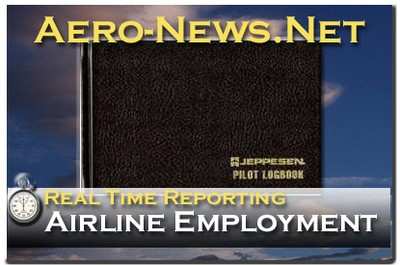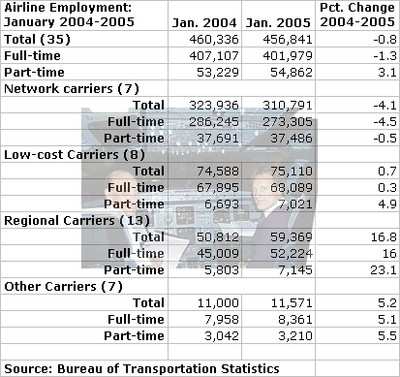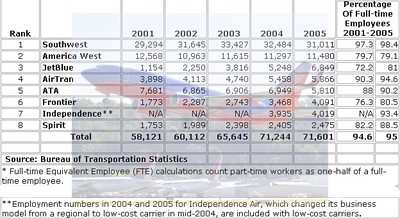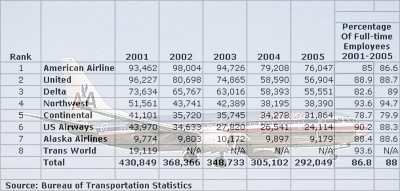January 2005 Airline Employment Down 0.8 Percent from January
2004
US scheduled passenger airlines employed a total of 456,841
workers in January 2005, 0.8 percent fewer than in January 2004,
the U.S. Department of Transportation's Bureau of Transportation
Statistics (BTS) reported Monday.

BTS, a part of the Research and Innovative Technology
Administration, reported that the seven network carriers employed
310,791 total workers, 4.1 percent fewer workers in January 2005
than a year earlier (Table 2). The low-cost carriers reported
75,110 total employees, 0.7 percent more than January 2004 (Table
3); and the regional carriers reported 59,369 total employees, 16.8
percent more than the previous year.

Airline employment numbers have been reported by carriers
meeting the reporting standard since at least 1970. This new
monthly series of press releases, including carrier groupings, is
designed to reflect the existing structure of the airline industry
and to provide numbers to measure the growing prominence of
low-cost and regional air carriers. Many regional carriers
were not required to report employment numbers before 2003, so
year-to-year comparisons involving regional carriers as a group, or
the full industry, are not appropriate for earlier years. BTS
is providing pre-2003 comparisons for network and low-cost
carriers, as well as pre-2003 numbers for individual regional
carriers that were required to report in earlier years.
Airlines that operate at least one aircraft with the capacity to
carry combined passengers, cargo and fuel of 18,000 pounds –
the payload factor – must report monthly employment
statistics.
The 2004 statistics do not include employment data for one
regional airline that was not required to report for that year
–- PSA Airlines.
Numbers for Independence Air, which changed its business model
from a regional to low-cost carrier in mid-2004, have been included
with low-cost carriers for both 2005 and 2004. This change
reflects that carrier's current business model as a low-cost
operator.

Using Full-Time Equivalent Employee (FTE) calculations, in which
part-time workers are counted as one-half of a full-time employee,
employment at network carriers in January dropped 31.9 percent from
2001 to 2005. The biggest declines were at US Airways, down
45.2 percent; and United Airlines, down 40.9 percent.
The seven low-cost carriers that were required to report
employment data in 2001 and 2005 employed 16.3 percent more FTEs in
2005 than in 2001.
Of the eight regional carriers who reported employment numbers
to BTS in 2001, the January FTEs increased 17.2 percent. Of
that group, only Horizon Air reported fewer FTE employees in
January 2005 than January 2001.

Network carriers operate a significant portion of their flights
using at least one hub where connections are made for flights to
down line destinations or spoke cities. Low-cost carriers are those
that the industry generally recognizes as operating under a
low-cost business model with fewer infrastructure costs.
Regional carriers provide service from small cities, using
primarily regional jets to support the network carriers' hub and
spoke systems.
The Other Carrier category generally reflects those airlines
that operate within specific niche markets such as Aloha and
Hawaiian Airlines in serving the Hawaiian Islands.
Data are compiled from monthly reports filed with BTS by
commercial air carriers as of March 16.
 ANN's Daily Aero-Linx (04.16.24)
ANN's Daily Aero-Linx (04.16.24) Aero-News: Quote of the Day (04.16.24)
Aero-News: Quote of the Day (04.16.24) Airborne 04.10.24: SnF24!, A50 Heritage Reveal, HeliCycle!, Montaer MC-01
Airborne 04.10.24: SnF24!, A50 Heritage Reveal, HeliCycle!, Montaer MC-01 Airborne 04.12.24: SnF24!, G100UL Is Here, Holy Micro, Plane Tags
Airborne 04.12.24: SnF24!, G100UL Is Here, Holy Micro, Plane Tags Airborne-Flight Training 04.17.24: Feds Need Controllers, Spirit Delay, Redbird
Airborne-Flight Training 04.17.24: Feds Need Controllers, Spirit Delay, Redbird






